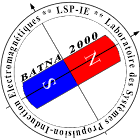, “Online robust estimation of flux and load torque in induction motors,” The International Journal of Advanced Manufacturing Technology , vol. 94, no. 5-8, pp. 2703–2713, 2018.
Équipe 04
, “Robust Sensorless Vector Control of an Induction Machine Using Multiobjective Adaptive Fuzzy Luenberger Observer,” ISA Transactions, vol. 74, pp. 74, 144-154, 2018.
, “Backstepping glycemic control of type 1 Diabetes for implementation on an embedded system,” The International Journal Bioautomation., vol. 22, no. 2, pp. 117-132, 2018.
, “Sensorless control and diagnosis of synchronous generator used in wind energy conversion system under inter turn short-circuit fault,” International Journal of Power and Energy Conversion, 2018.
, “High Efficiency Induction Motor Drives Using Type-2 Fuzzy Logic,” The European Physical Journal Plus, vol. 133, no. 3, 2018.
, “Higher Order Sliding Mode Control for Blood Glucose Regulation of Type 1 Diabetic Patients,” International Journal of System Dynamics Applications (IJSDA), vol. 7, no. 1, pp. 65-84, 2018.
, “Management, optimization and conversion of energy for self-governing house,” 2017 International Conference on Control, Automation and Diagnosis (ICCAD),Hammamet, Tunisia. pp. 429-433, 2017.Abstract
, “A real-time Backstepping control strategy for a doubly fed induction generator based wind energy conversion system,” 2017 6th International Conference on Systems and Control (ICSC), Batna, Algeria. pp. 549-554, 2017.
, “Optimal energy control of a PV-fuel cell hybrid system,” International Journal of Hydrogen Energy, vol. 42, no. 2, pp. 1456-1465, 2017.Abstract
, “Degradation and performance evaluation of PV module in desert climate conditions with estimate uncertainty in measuring,” Serbian Journal of Electrical Engineering, vol. 14, no. 2, pp. 277-299, 2017.Abstract
, “Experimental investigation of effects of partial shading and faults on photovoltaic modules performances,” Leonardo Electronic Journal of Practices and Technologies, no. 31, pp. 183-200, 2017.Abstract
, “Real-time integration of control strategies for an isolated DFIG-based WECS,” The European Physical Journal Plus , vol. 132, no. 8, pp. 334, 2017.
, “Implementation and comparative study of control strategies for an isolated DFIG based WECS,” vol. 132, no. 10, pp. 415, 2017.Abstract
, “Sliding mode control of grid connected brushless doubly fed induction generator driven by wind turbine in variable speed,” International Journal of System Assurance Engineering and Management, vol. 8, no. 2, pp. 788-798, 2017.Abstract
, “A comparative study of PI and Sliding mode controllers for autonomous wind energy conversion system based on DFIG,” 17th International conference on Sciences and Techniques of Automatic control & computer engineering , STA'2016. 2016.
